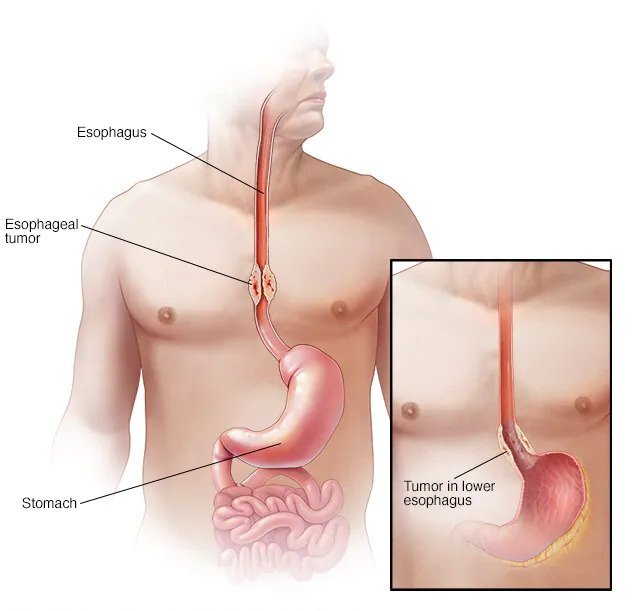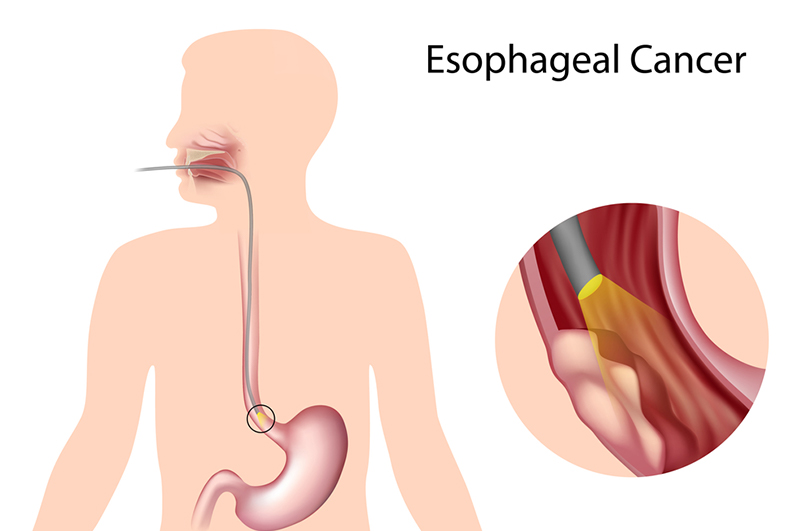Everything You Need to Know About Esophageal Cancer
Smith, a 48-year-old, is a businessman from Nairobi, Kenya. He is a father of three kids and husband of a beautiful wife. He is running his Logistics business, having a presence in 5 cities in Kenya.
Five years ago, Smith had started experiencing difficulty in swallowing food, indigestion, and heartburn. After ignoring a month, Smith visited a nearby doctor. The doctor examined Smith’s abdomen but found nothing abnormal. He prescribed a few medications. The medications helped him get some relief, but after 15-20 days, the problems started bothering him again.
He decided to meet a gastroenterologist. The doctor suggested gastroscopy and blood tests for Smith.
Smith underwent a gastroscopy, and the doctor detected a tumor in Smith’s esophagus, and the doctor suspected it was a malignant tumor. The doctor recommended a CT scan to investigate further. The CT scan reflected that the tumor was present in local lymph nodes and had not spread from the esophagus into other organs.
Smith and his family were shocked to hear that. However, Smith’s best friend Danny and business partner motivated the family to fight cancer and suggested that he not take any risks and go for esophageal cancer treatment in India. Danny already knew MedicoExperts as he did his mother’s knee replacement surgery in India. Danny gave the MedicoExperts contact details to Smith.


Smith got in touch with MedicoExperts and forwarded all his reports. The MedicoExperts team presented the case to the tumor board. The board recommended a tentative protocol with a combination of surgery, chemotherapy, and targeted therapy and suggested the final protocol can be arrived at after thorough evaluation, including a PET Scan. The family also had a video call with the head of the board and understood the tentative protocol thoroughly.
Smith decided to come to India with his wife for the treatment.
After 15 days, Smith and Linda came to India for treatment, and Smith got admitted to the hospital. The evaluation was performed to check the current condition of the cancer. Reports came, and the examination confirmed that cancer had not spread to adjacent tissue or organs and that it had entered only a few immediately adjacent lymph cells.
The doctor started chemotherapy, and after 2 cycles, esophageal cancer surgery was performed. The cancer was removed along with 52 lymph nodes.
After the successful surgery, Smith is slowly getting back into the day-to-day routine,e and a reevaluation test was performed; the reports verified the successful removal of cancer.
Smith and Linda were very happy with the outcome and thanked the doctor and MedicoExperts.
Before starting the discussions on different treatment options, let’s first understand what esophageal cancer is?
The esophagus is a muscular tube that is responsible for moving food from the throat to the stomach, and Esophageal Cancer occurs when a malignant tumor forms in the lining of the esophagus.
Cancer starts when cells in the inner lining of the esophagus grow out of control. A tumor can occur anywhere along the length of the esophagus, including the place where the esophagus and stomach meet.

There are different stages for different types of Esophageal cancer. Doctors use a tool called as TNM system to describe the stage of cancer:
Tumor (T) – It indicates how intensely the primary tumor has grown into the wall of the esophagus and the surrounding tissue.
Node(N) – It shows if the tumor has spread to lymph nodes, where and how many?
Metastasis (M) – It shows if cancer has spread to other parts of the body, where and how much?
These results are combined to determine the stage of esophageal cancer for everyone. There are 5 stages, and doctors often describe the type of cancer by its grade. The grade describes how much cancer cells look like healthy cells when viewed under the microscope. If esophageal cancer looks like healthy tissue and contains different cell grouping, then it is called “differentiated”. If the esophageal cancer cells look different from healthy tissue, it is called “poorly differentiated”.
Stages of Squamous Cell Carcinoma
The stages of squamous cell carcinoma may be divided based on whether the tumor is in the upper, middle, or lower part of the esophagus, as well as the grade of the cancer cells.
The cancer is found in the top lining of the esophagus. It has not spread to deep layers and has not spread to any lymph nodes or distant organs.
The cancer grade does not apply and can be located anywhere in the esophagus.
Stage IA – The cancer is in the top layers of the esophagus. Cancer has not spread to any lymph nodes or distant organs.
The cancer is in grade 1 or in an unknown grade and located anywhere in the esophagus.
Stage IB – Cancer can be in either condition:
- The cancer is in the top layers of the esophagus, but the cancer cells are less differentiated.
- The cancer is in the third layer of the esophagus but has not spread to the lymph nodes or other parts of the body.
Cancer can be in any grade or an unknown grade and located anywhere in the esophagus.
Stage IIA – It can be any of these conditions:
- The cancer is in the third layer of the esophagus and has spread into the thick muscle layer of the esophagus.
- The cancer is in the outer layer of the middle or upper part of the esophagus.
- The cancer is in the outer layer of the lower part of the esophagus.
Cancer might be in grade 2 or 3 and located anywhere in the esophagus.
Stage IIB – It can be any of the following conditions:
- The cancer cells are in the outer layer of the upper or middle part of the esophagus. The cancer cells are less differentiated.
- The cancer cells are in the outer layer of any part of the esophagus.
- The cancer cells have spread into the lining of the esophagus and layers below.
Cancer can be in grades 2-3 or any grade and located anywhere in the esophagus.
Stage IIIA – It can be any of the following conditions:
- Cancer has spread into the lining of the esophagus and layers below. Cancer has spread to 3 to 6 lymph nodes near the tumor.
- The tumor has developed into the third layer of the esophagus and has spread to 1 or 2 lymph nodes.
- Cancer has spread outside the esophagus to nearby tissues and but has not spread to lymph nodes or any other parts of the body.
Cancer can be of any grade and can be located anywhere in the esophagus.
Stage IIIB – It can be any of these conditions:
- Cancer has grown into the third layer of the esophagus and has spread to 3 to 6 lymph nodes.
- Cancer has developed into the outer layer of the esophagus and has spread to either 1 to 2 or 3 to 6 lymph nodes.
- Cancer has spread to structures surrounding the esophagus and has spread to either no nodes or 1 to 2 lymph nodes.
Cancer can be of any grade and located anywhere in the esophagus. It has not spread to distant organs.
Stage IVA – It can be either of these conditions:
- Cancer has spread to nearby structures and may have spread to 3 to 6 lymph nodes.
- Cancer has spread to 7 or more lymph nodes.
It can be located anywhere in the esophagus.
Stage IVB – Cancer has spread to other parts of the body, such as the liver and lungs.
Cancer can be of any grade and located anywhere in the esophagus.
Stages of Adenocarcinoma
Doctors use both T, N, M classifications and the grade for these stages of cancers:
The cancer is found in the top lining of the esophagus. It has not started to grow in the deep layers. The cancer grade does not apply.
Stage IA – The tumor has spread into the lining of the esophagus and underneath layers.
It has not spread to distant organs or lymph nodes.
Stage IB – Cancer can meet either of the following conditions:
- Cancer has spread below the lining of the esophagus. The cancer cells are moderately differentiated.
- The tumor has grown into the layers of the esophagus called the submucosa.
Cancer can be of grade 1, 2 or an unknown grade.
Stage IC – Cancer can meet either of the following conditions:
- The tumor has grown below the lining of the esophagus or the submucosa. The cancer cells are poorly differentiated here.
- Cancer has expanded into the third layer of the esophagus and is well or moderately differentiated.
Cancer can be grade 1, 2 or 3.
Stage IIA – cancer cells are in the third layer of the esophagus. They can be grade 3 or an unknown grade.
Stage IIB – It can be either of these conditions:
- The tumor has spread to the outer layer of the esophagus.
- Cancer is in the inner layer of the esophagus and has spread to 1 or 2 lymph nodes.
Stage IIIA – It can be either of these conditions:
- Cancer is in the inner layers of the esophagus and has spread to 3 to 6 lymph nodes.
- Cancer is in the third layer of the esophagus and has stretched to 1 or 2 lymph nodes.
Stage IIIB – It can be any of these conditions:
- Cancer is in the third layer of the esophagus and has spread to 3 to 6 lymph nodes.
- Cancer is in the surface layer of the esophagus and has spread to either 1 to 2 or 3 to 6 lymph nodes.
- Cancer has spread to structures near the esophagus and either no lymph nodes or 1 or 2 lymph nodes.
Stage IVA -,It can be either of the following conditions:
- Cancer has spread to structures near the esophagus and either no lymph nodes or 3 to 6 lymph nodes.
- Cancer has spread to 7 or more lymph nodes.
Stage IVB – Tumor has spread to other parts of the body, such as the liver and lungs. Cancer can be any grade.
Frequently Asked Questions (FAQs):
Q1. Is esophageal cancer curable?
A. Esophageal cancer is an aggressive cancer and, in most cases, is a treatable disease, though cure rates are low. It depends on several factors like the stage of cancer and the overall health of the patient. People with early-stage disease have a better chance of survival.
Q2. Is esophageal cancer hereditary?
A. It happens in a person’s lifetime and is not passed on to their children. Hence, it is not inherited but acquired during a person’s life.
Q3. Do you feel ill with esophageal cancer?
A. It might be hard to spot at an early stage, but once cancer progresses, it affects your digestion, such as having a problem swallowing.
Q4. At what age does esophageal cancer occur?
A. It is most often diagnosed at the age of 50 and above and is more common in men than women.
Q5. How fast does esophageal cancer progress?
A. It grows slowly for many years, and once the symptoms development can progress rapidly.
Q6. Can acid reflux cause esophageal cancer?
A. Adenocarcinoma of the esophagus is slightly more common in people with chronic acid reflux, gastroesophageal reflux disease (GERD), Barrett’s esophagus, and chronic heartburn.
Q7. What foods should esophageal cancer patients avoid?
A. Patients should avoid the foods which is difficult to eat
- Raw fruit and vegetables.
- Tough meat.
- Soft, doughy bread.
Q8. How do you get esophageal cancer?
A. The uncontrolled multiplication of cells lining the food pipe can result in esophageal cancer. This is frequently linked to irritation caused by tobacco, alcohol, and stomach contents refluxing back into the esophagus.
Q9. What does Barrett's esophagus have to do with esophageal cancer?
A. Barrett’s esophagus is a condition in which the cells in the esophageal lining begin to change. Barrett’s esophagus is more common in people who have acid reflux disease (GERD), but it can also happen to people who don’t have GERD. This condition has been linked to an increased risk of developing esophageal adenocarcinoma.
Although only a small percentage of people with Barrett’s esophagus develop esophageal cancer, it’s critical that they keep an eye on the condition in case they are.
Q10. What are some of the potential side effects of esophageal cancer treatment?
A. Depending on the type of treatment given, side effects may vary from patient to patient. Fatigue, nausea and vomiting, diarrhea, hair loss, pain while swallowing, digestive problems, headaches, bleeding, and other side effects are all possible.
Depending on the severity of their condition and treatment plan, some people may need to eat smaller, more frequent meals after treatment. Retraining their swallowing skills may also require occupational or speech therapy.
Next in Esophageal Cancer

Author Bio:
Dr. Yashashree Joshi – MBBS, MD (Philippines)
Dr. Yashashree Joshi, MD, is a globally-trained oncologist with a robust academic background and extensive experience in pioneering cancer treatments. Dedicated to patient-centered care, she continually integrates the latest advancements in oncology to provide her patients with innovative and personalized treatment plans.
Content Medically Reviewed By MedicoExperts Editorial & Clinically Review Board




